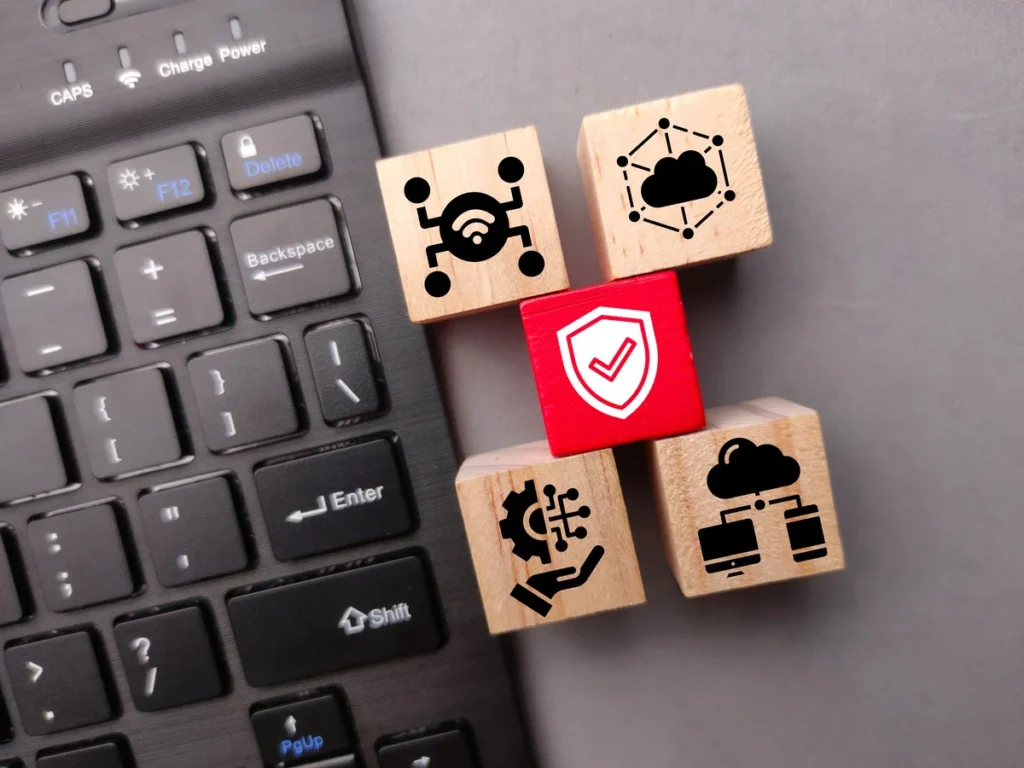In cybersecurity, risk management involves locating, evaluating, and reducing possible risks that might compromise the integrity of an organisation’s digital assets. Organisations can effectively manage cyber risks and protect against potential threats by putting best practices like employee training, incident response planning, and regular security assessments into practice.
So, what does risk management mean, what are the different types, and what are the best practices for it? Continue reading to learn more.
What Is Risk Management in Cyber Security?
Cybersecurity risk management is the systematic process of identifying, analysing, evaluating, and responding to cybersecurity threats within an organisation.
To effectively safeguard an organisation’s digital assets and operations, it is necessary to fully understand potential threats, vulnerabilities, and consequences. Natural disasters, inadvertent human error, hostile attacks, and system malfunctions are all included.
The process also includes determining the likelihood of a threat event occurring, performing an impact analysis to estimate potential consequences, implementing security controls to address vulnerabilities, and continuously monitoring the environment to ensure that internal controls are in line with the organisation’s risk tolerance.
In the end, robust cybersecurity risk management is vital to safeguarding the security and resilience of an organisation’s digital assets and operations.
One important aspect of risk management occurs during the backend development process. But what does the term “backend development” mean? Find out more in our article, “Back-End Development: What It Is and How It Differs From Front-End“.
Types of Risks
There are various types of cybersecurity risks that can potentially compromise business digital assets and operations. Ransomware, phishing, and DoS attacks are some of the types of risks that are commonly faced by businesses. These risks can result in financial loss, reputational damage, and disruption of business operations.
In addition to that, here are all of the known types of cybersecurity risks:
- Malware and Ransomware: Malicious software designed to disrupt, damage, or gain unauthorized access to computer systems, often for financial gain.
- Phishing and Social Engineering: Deceptive tactics used to trick individuals into revealing sensitive information or performing actions that may compromise security.
- Insider Threats: Risks posed by employees, contractors, or business partners who have access to sensitive information and may misuse it intentionally or unintentionally.
- Denial-of-Service (DoS) Attacks: Attempts to make a machine or network resource unavailable to its intended users, often by overwhelming it with a flood of internet traffic.
- Data Breaches: Unauthorized access to sensitive or confidential information, leading to its exposure, theft, or compromise.
- Third-Party Risks: Risks associated with the security posture of third-party vendors, suppliers, or partners who have access to an organization’s systems or data.
- IoT Vulnerabilities: Security weaknesses in Internet of Things (IoT) devices, which can be exploited to gain unauthorized access to networks or data.
- Regulatory and Compliance Risks: Risks associated with failing to comply with industry regulations or data protection laws, leading to legal and financial consequences. Understanding these types of cybersecurity risks is essential for organisations to proactively implement measures to mitigate and manage these threats effectively.
Risk Identification and Assessment
The initial stages of the cybersecurity risk management process include risk identification and assessment. It consists of scoping, risk identification, analysis, evaluation, and documentation. This process helps organizations to understand the potential impact of various cybersecurity risks on their operations and reputation.
According to TechTarget, the steps for risk identification and assessment are as follows:
- Scope the Assessment: Determine the scope of the assessment, which could be the entire organisation, a business unit, location, or specific aspect of the business.
- Identify Assets: Identify and create an inventory of all physical and logical assets within the scope of the assessment.
- Identify Threats: Use threat libraries, such as the MITRE ATT&CK Knowledge Base and resources from the Cyber Threat Alliance, to help identify potential threats to each asset.
- Identify Vulnerabilities: Specify the consequences of an identified threat exploiting a vulnerability to attack an in-scope asset.
- Assess Risks: Evaluate the likelihood of threats occurring and the potential impact of vulnerabilities being exploited.
- Document Findings: Document the assessment results, including the identified risks, their likelihood, potential impact, and recommended mitigation strategies.
Create a risk assessment report that details the prioritised threats, vulnerabilities, and risks to each asset, as well as suggested mitigation strategies. Share the report with the appropriate stakeholders for review and implementation of security measures.

Risk Mitigation and Control
Cybersecurity risk mitigation is the process of reducing the overall risk or impact of a cybersecurity incident by employing strategies and controls. There are three main components to risk mitigation: prevention, detection, and remediation.
Putting precautions in place to stop cyberattacks is known as prevention. Strong password usage, firewall installation, and staff security awareness training are a few examples.
Monitoring systems and networks to find potential threats and vulnerabilities is the process of detection. Security information and event management (SIEM) systems and intrusion detection systems are two examples of tools that can aid in detection.
After a cyberattack has happened, remediation means reacting to it. This can include removing malware, patching vulnerabilities, and backing up data.
Virtu’s blog outlines at least 6 steps for effective cybersecurity risk mitigation strategies, including:
- Establish Network Access Controls: Implement network access controls to help mitigate the risk of insider threats.
- Continuously Monitor Network Traffic: Monitor network traffic to detect and address emerging threats in a timely manner.
- Create an Incident Response Plan: Have a comprehensive incident response plan in place to ensure a coordinated response to cyber attacks.
- Use Security Ratings: Utilise security ratings to identify high-risk vendors and internal assets in real-time.
- Implement a Patch Management Schedule: Keep software up-to-date to stay ahead of attackers.
- Maintain Ongoing Vulnerability Management: Regularly assess and address vulnerabilities to minimise the attack surface.
Organisations can effectively manage cybersecurity risks by implementing these strategies, which reduce the likelihood and impact of cyber attacks.
Tools and Technologies for Risk Management
Defendify, Metasploit Framework, Burp Suite, ZenGRC, and Active Risk Manager are some of the known tools and technologies for cybersecurity risk management. These tools offer various features, such as vulnerability scanning, penetration testing, and compliance management, to help organisations proactively identify and mitigate potential security threats.
1. Defendify
An all-in-one product that provides multiple layers of protection and offers consulting services if needed. Features include cybersecurity risk assessments, technology and data use policies, incident response plans, penetration testing, threat alerts, phishing simulations, and cybersecurity awareness training.
2. Metasploit Framework
A tool that can test computer system vulnerabilities or be used to break into remote systems. It is known as a network penetration “Swiss Army knife” used by both ethical hackers and criminal gangs to probe networks and applications.
3. Burp Suite
A suite of tools specifically focused on debugging and testing web app security. It includes a spider for crawling web app content, a randomness tool for testing session tokens, and a sophisticated request repeater to resend manipulated requests.
4. ZenGRC
A comprehensive cybersecurity risk management tool that offers features like audit management, automated audit evidence collection, compliance management, contract management, and routine compliance.
5. Active Risk Manager
A cybersecurity risk management tool that focuses on compliance management, audit management, internal controls management, risk assessment, and legal risk management.
Another part of security risk management is in the backend frameworks. But what do backend frameworks mean? Learn more in our article, “Back End Frameworks: What It Is, Popular Choice, and How to Pick The Best“.
Conclusion
Ultimately, in order for organisations to successfully navigate the increasingly complex and unpredictable business landscape, it is critical that they implement a strong risk management framework.
Businesses may prevent operational risks and guarantee long-term success and sustainability by comprehending the various risk types, utilising cutting-edge technologies, implementing strong mitigation plans, and implementing efficient identification and assessment techniques.
Protecting your company’s data from cyber threats requires experts in cybersecurity to assess vulnerabilities and implement necessary measures. That’s why, at some point, you may require assistance from IT professionals, such as Nexa Lab security hardening services.
We provide a wide range of cyber security services, including vulnerability assessments, application security enhancements, incident response planning, custom security strategies, access control and authentication, and security awareness training.
Nexa Lab was founded and established in Australia, with over 30 years of experience in the MSP and IT industries. With a commitment to cybersecurity, we prioritise protecting Australian businesses’ digital assets and sensitive data.




